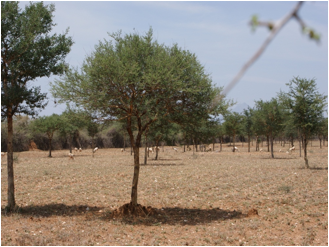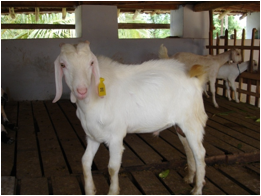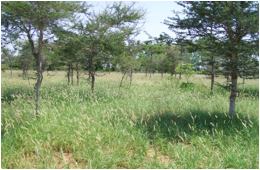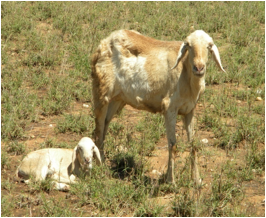
About 5.58 million hectares of agriculture land in the state, which is currently more than half of the land, i.e. about 2.31 ??million hectares of land are fall under fallow or rainfed land. Due to minimal or no source of water, dryland and fallow land which is less fertile, cultivated by the farmers could not get a steady income throughout the year and facing great difficulties. They have a great sense of clear with a steady income, improving the lives of their families,the federal, central and state governments has taken a number of paving projects. Particularly, in the 12th five Year plan, integrated farming system project plays an important role. At this moment, What is integrated farming? and how to implement them especially suitable for rainfed and fallow land, it is necessary to understand better how to setting up an integrated farming system. What is integrated farming? Let's see how. Integrated farming is not only do one task of agriculture, together with two or more farm-related agriculture task are collectively called as integrated farming.
In India, not only high number of dairy cows but also goats, sheep, pigs and chickens are available. Agriculture and livestock is major enterprises in our country which produces 100 million tonnes of plant and animal waste annually. Based on farmers' land, irrigation facilities, drainage and variety of economic conditions, different dry or barren land integrated farming system models are developed in Tamil Nadu which are currently in use.
Sheep farming with grain crops:
- Growing fodder trees in intercropping system
- Fodder production between fruit trees
 Sheep farming with cereals and orchards with agro forestry systems were suitable to to dry and barren lands. Similarly, animal husbandry gives more profit especially sheep and goats. Buffalo and cattle rearing is also the most profitable one. In our country, rearing of one or more cattles in houses shifted into livestock farming as a profitable business. Animal protein which is needed for humans that not only fulfill human needs but also helps to increase the farmer’s economic status and improves livelihood. Growing population, modernization, industrialization and residential occupation of the land resulting in the countryside farming land and natural grazing land has begun to dwindle day by day. This situation further worsens the fodder availability and increased fodder demand which affects production. The mismatching of number of sheep in our country to the productivity was mainly due to decreased fodder crops and lack of proper management of fodder crops. Sheep farming with cereals and orchards with agro forestry systems were suitable to to dry and barren lands. Similarly, animal husbandry gives more profit especially sheep and goats. Buffalo and cattle rearing is also the most profitable one. In our country, rearing of one or more cattles in houses shifted into livestock farming as a profitable business. Animal protein which is needed for humans that not only fulfill human needs but also helps to increase the farmer’s economic status and improves livelihood. Growing population, modernization, industrialization and residential occupation of the land resulting in the countryside farming land and natural grazing land has begun to dwindle day by day. This situation further worsens the fodder availability and increased fodder demand which affects production. The mismatching of number of sheep in our country to the productivity was mainly due to decreased fodder crops and lack of proper management of fodder crops.
Sheep Farming in integrated farming in rainfed lands gives a better profit. In such land, raising crops such as tree kind of forage crops like Supapul, Gliricidia, kodukkappuli, Neem, Surrogate, Agathi, Sithaagathi, Achan, Udiyan, Thespesia and Kalyana murungai trees are planned to this type of land. Protein and mineral content is high in the leaves and pods.The tree leaves is filled with nutrients other than forage crops. Not only this, just not giving forage crops to sheep, cereal grains or mixed with the green cause increase productivity by reducing the cost of concentrated feed.
Maize and Stylo suitable for rainfed land: Grain production in rainfed land like sorghum, pearl millet were followed once in a year. Once the crops harvest was finished, the respective land is kept as fallow. Instead of this, with agricultural crops such as sorghum and pearl millet @ 5.5 kg per acre seeds mixed with the soil to be scattered in the landscape. Maize grows very quickly compared with stylo. At this stage, after the completion of harvest of maize for grain, passing of direct sunlight to Stylo. Crop yield and harvested fodder needed for livestock year round availability except this, their seeds fell in the respective land and plough the land next year monsoon rain when cultivating the maize in the year-round availability of fodder for livestock. In this system, deployment of nitrogen in the soil, increasing the yield of maize.
Intercropping of wood in rainfed lands
 In rainfed lands fodder tree species are planted in certain closer intervals in east-west direction and cultivating agricultural crops in the inter-row spaces called as intercropping cultivation method. Around the land instead of constructing metal fence livestock fodder and firewood capable of giving this materials and planting them to act as a bio fence. In rainfed lands fodder tree species are planted in certain closer intervals in east-west direction and cultivating agricultural crops in the inter-row spaces called as intercropping cultivation method. Around the land instead of constructing metal fence livestock fodder and firewood capable of giving this materials and planting them to act as a bio fence.
Sapota, Guava and green fodder in rainfed land: In this method, sapota or Guava orchards were planted with Co-4 grass as intercrop and also cultivating Subapul, Glyricidia in the border and cultivation of protein rich hen masal inside or middle of the garden. Rearing of 6 to 12-month-old sheep with this could promote the growth of the body to 53 g and 44 g, respectively per day.
In another kind of study, cultivation of Guinea grass with guava or sapota can get 48 tons per hectare and whereas in Turmeric garden combined with fodder Horse gram yielded 5-8 tons of green fodder.
Like this in rain fed land, mango tree with groundnut or mixture of horse gram or fodder sorghum yielded 190, 207 and 234 kg of protein rich fodder can be able to produced. Similarly, growing karamani with mango trees yielded 170 kg protein source in the 3.25 tonnes of karamani fodder. It can support 10 to 12 sheep around the year.
Neem + Sheep farming in rainfed land

Growing fodder sorghum in the 5m inter space of Neem plantations produces 4.2 tonnes of Sorghum stalk per hectare. Mixing of 150 gram of neem leaves with sorghum stalk increased the body weight of sheep up to 45g per day.whereas when it was fed with gliricidia leaves increased the body weight up to 58g per day.
Orchard + Agro forestry:
In a hectare of fallow land, minimum 2 acres land to be utilized for cultivation of grain and fruit crops. Particularly, fruit crops viz., guava, pomegranate and sappota can be developed under drip irrigation method.
In Mullai gracing create Agro-Forestry, for sheep, fodder trees like Suba pul, glyricidia, drumstick etc.,with kolukkattaipul, Stylo such green plant and pulses kind fodder will be grown.
In mullai grazing land, the fodder trees suitable for sheep like supapul, gliricidia and kalyanamurungai were grown with buffel and stylosanthes kind of grass and legume fodder can be cultivated.
|


 Sheep farming with cereals and orchards with agro forestry systems were suitable to to dry and barren lands. Similarly, animal husbandry gives more profit especially sheep and goats. Buffalo and cattle rearing is also the most profitable one. In our country, rearing of one or more cattles in houses shifted into livestock farming as a profitable business. Animal protein which is needed for humans that not only fulfill human needs but also helps to increase the farmer’s economic status and improves livelihood. Growing population, modernization, industrialization and residential occupation of the land resulting in the countryside farming land and natural grazing land has begun to dwindle day by day. This situation further worsens the fodder availability and increased fodder demand which affects production. The mismatching of number of sheep in our country to the productivity was mainly due to decreased fodder crops and lack of proper management of fodder crops.
Sheep farming with cereals and orchards with agro forestry systems were suitable to to dry and barren lands. Similarly, animal husbandry gives more profit especially sheep and goats. Buffalo and cattle rearing is also the most profitable one. In our country, rearing of one or more cattles in houses shifted into livestock farming as a profitable business. Animal protein which is needed for humans that not only fulfill human needs but also helps to increase the farmer’s economic status and improves livelihood. Growing population, modernization, industrialization and residential occupation of the land resulting in the countryside farming land and natural grazing land has begun to dwindle day by day. This situation further worsens the fodder availability and increased fodder demand which affects production. The mismatching of number of sheep in our country to the productivity was mainly due to decreased fodder crops and lack of proper management of fodder crops.  In rainfed lands fodder tree species are planted in certain closer intervals in east-west direction and cultivating agricultural crops in the inter-row spaces called as intercropping cultivation method. Around the land instead of constructing metal fence livestock fodder and firewood capable of giving this materials and planting them to act as a bio fence.
In rainfed lands fodder tree species are planted in certain closer intervals in east-west direction and cultivating agricultural crops in the inter-row spaces called as intercropping cultivation method. Around the land instead of constructing metal fence livestock fodder and firewood capable of giving this materials and planting them to act as a bio fence. 